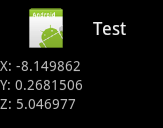This is am going to teach to make is so simple but I could be playing with it for hours, just think of all the possibilities.
The Result
We will make a simple app, one that shows you the acceleration of your phone/tablet in all axes. The acceleration won’t be zero when your are not moving though but the numbers for each axis will change when you tilt your device in any direction.

Android app showing accelration in the x y and z axes.
The Java Code(HelloAndroid.java)
package com.example.helloandroid;
import android.app.Activity;
import android.hardware.Sensor;
import android.hardware.SensorEvent;
import android.hardware.SensorEventListener;
import android.hardware.SensorManager;
import android.os.Bundle;
import android.widget.TextView;
public class HelloAndroid extends Activity implements SensorEventListener {
private SensorManager sensorManager;
TextView xCoor; // declare X axis object
TextView yCoor; // declare Y axis object
TextView zCoor; // declare Z axis object
@Override
public void onCreate(Bundle savedInstanceState){
super.onCreate(savedInstanceState);
setContentView(R.layout.main);
xCoor=(TextView)findViewById(R.id.xcoor); // create X axis object
yCoor=(TextView)findViewById(R.id.ycoor); // create Y axis object
zCoor=(TextView)findViewById(R.id.zcoor); // create Z axis object
sensorManager=(SensorManager)getSystemService(SENSOR_SERVICE);
// add listener. The listener will be HelloAndroid (this) class
sensorManager.registerListener(this,
sensorManager.getDefaultSensor(Sensor.TYPE_ACCELEROMETER),
SensorManager.SENSOR_DELAY_NORMAL);
/* More sensor speeds (taken from api docs)
SENSOR_DELAY_FASTEST get sensor data as fast as possible
SENSOR_DELAY_GAME rate suitable for games
SENSOR_DELAY_NORMAL rate (default) suitable for screen orientation changes
*/
}
public void onAccuracyChanged(Sensor sensor,int accuracy){
}
public void onSensorChanged(SensorEvent event){
// check sensor type
if(event.sensor.getType()==Sensor.TYPE_ACCELEROMETER){
// assign directions
float x=event.values[0];
float y=event.values[1];
float z=event.values[2];
xCoor.setText("X: "+x);
yCoor.setText("Y: "+y);
zCoor.setText("Z: "+z);
}
}
}
The Layout(main.xml)
Just three text labels, one for each axis.
<?xml version="1.0" encoding="utf-8"?> <TableLayout xmlns:android="http://schemas.android.com/apk/res/android" android:layout_width="fill_parent" android:layout_height="fill_parent"> <TableRow> <TextView android:id="@+id/xcoor" android:text="X Coordinate: " android:layout_width="wrap_content" android:layout_height="wrap_content" /> </TableRow> <TableRow> <TextView android:id="@+id/ycoor" android:text="Y Coordinate: " android:layout_width="wrap_content" android:layout_height="wrap_content" /> </TableRow> <TableRow> <TextView android:id="@+id/zcoor" android:text="Z Coordinate: " android:layout_width="wrap_content" android:layout_height="wrap_content" /> </TableRow> </TableLayout>
The Manifest(AndroidManifest.xml)
<?xml version="1.0" encoding="utf-8"?>
<manifest xmlns:android="http://schemas.android.com/apk/res/android"
package="com.example.helloandroid"
android:versionCode="1"
android:versionName="1.0">
<uses-sdk android:minSdkVersion="13" />
<uses-permission android:name="android.permission.INTERNET" />
<application android:icon="@drawable/icon" android:label="@string/app_name" android:debuggable="true">
<activity android:name=".HelloAndroid"
android:label="@string/app_name">
<intent-filter>
<action android:name="android.intent.action.MAIN" />
<category android:name="android.intent.category.LAUNCHER" />
</intent-filter>
</activity>
</application>
</manifest>